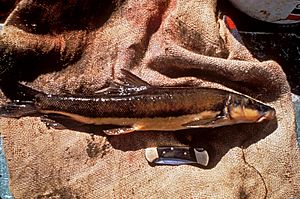Longnose sucker facts for kids
Quick facts for kids Longnose sucker |
|
|---|---|
 |
|
 |
|
| Conservation status | |
| Scientific classification | |
| Subspecies | |
|
|
| Synonyms | |
|
The longnose sucker (Catostomus catostomus) is a type of freshwater fish. It belongs to the sucker family. You can find this fish in cold rivers and lakes across North America. Its range goes from the northern United States all the way to the top of the continent. It also lives in Russia, in rivers in eastern Siberia. This makes it one of only two types of sucker fish found in Asia.
Contents
What Does It Look Like?
The longnose sucker has a long, round body. Its top and sides are usually dark olive or gray. Its belly is light. These fish can grow up to about 64 centimeters (25 inches) long. They can weigh up to 3.3 kilograms (7.3 pounds).
Longnose suckers look a lot like white suckers. It can be hard to tell them apart. However, longnose suckers have much smaller scales. This is the easiest way to tell them from white suckers.
Where It Lives and What It Eats
Longnose suckers like cold, clear water. They live in lakes, pools, rivers, and streams. Sometimes, they can even be found in brackish water, which is a mix of fresh and salt water. In North America, they live in many river basins. These include the Columbia, Delaware, Missouri, and Monongahela rivers. They also live in the Great Lakes basin. The longnose suckers in Russia are sometimes called Siberian suckers. They live in the Yana, Indigirka, Alazeya, and Kolyma river basins.
This fish is a bottom-feeder. This means it eats food it finds on the bottom of the water. Their diet includes aquatic plants, algae, and small invertebrates. Longnose suckers are also food for bigger fish. These predators include bass, walleye, trout, northern pike, muskellunge, and burbot.
Longnose Suckers and People
People fish for longnose suckers for fun and for food. They are also used as bait to catch the larger fish that eat them. The world record for catching a longnose sucker is 6 pounds 9 ounces. This fish was caught in the St. Joseph River in Michigan.
See also
 In Spanish: Catostomus catostomus para niños
In Spanish: Catostomus catostomus para niños


